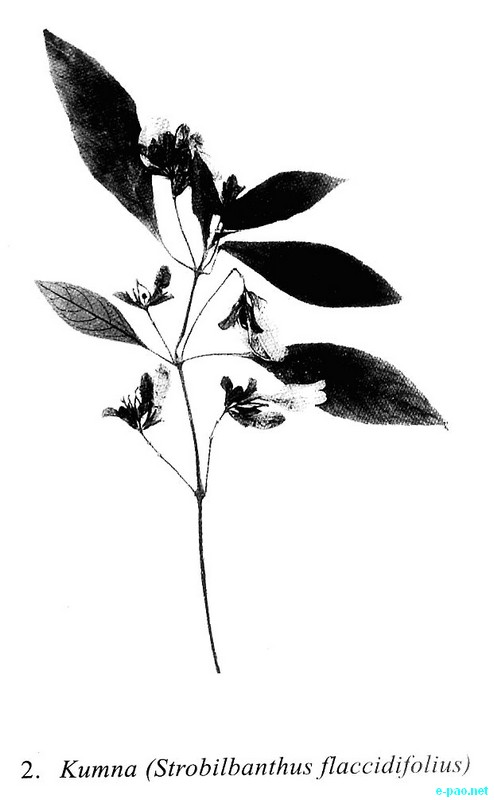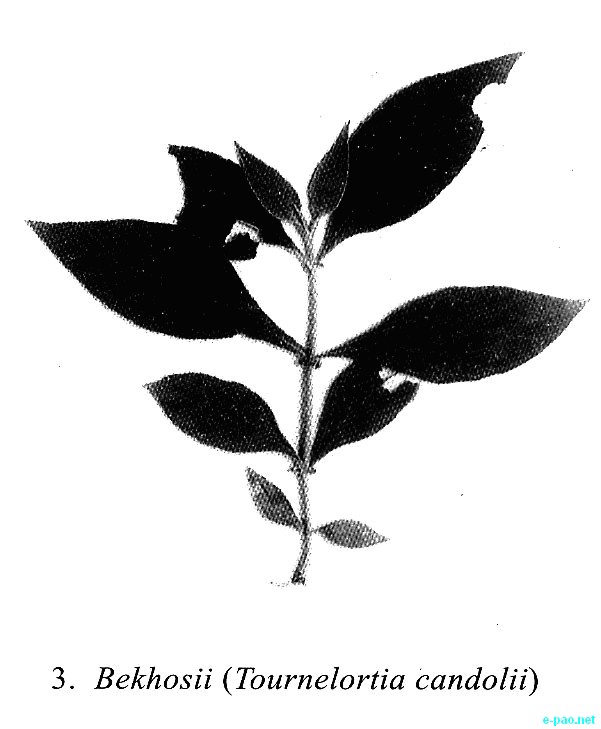Tribal hand woven fabrics of Manipur
- Part 2 -
By: Mutua Bahadur *
VEGETABLE DYE
In the past, both valley and hill dwellers of Manipur practised dyeing by using varieties of plant leaves and barks. The tribal people predominantly used the black colorants. They used the red and the yellow colours to a lesser degree. But at present, they have abandoned their traditional technique of dyeing. The young generation are not only inexperienced in the indigenous art of dyeing the textiles but also lack the know-how about it.
Like the peoples of South-East Asia , the Meiteis, from the early times, extracted the indigo colour from Kumna (Strobilbathus flaccidifolius) (Fig.2). Some tribes of Manipur, such as the Chothe, the Kharam, the Thadou, the Gangte, the Vaiphei, the Sukte, the Aimol, the Maring, the Koireng, etc. also used the Kumna plant to prepare dye for textiles. However, instead of indigo colour, the tribal people recognised it as a flora to extract the black colour. They repeated the same process of dyeing so as to concentrate the colour and to obtain black coloured textile. But some tribes possess the skill of mixing other ingredients to the Kumna solution to get the proper black colour.
Since the reign of King Khagemba (1597-1652 A.D.), the Maring, the Thangal, the-Chothe, the Makhan, etc. paid compulsorily a pon of Kumna annually as tribute to the Meitei kings. About a decade ago, the Thadou at the Setjang village, which lies along the present-day Imphal-Jiri Road, bartered Heijugang (Juglans regia) with the Kharam at the Kharam Pallel, for the Kumna plants.
Even for some years after the World War II, the tribal folk practised the dyeing of textiles for their own individual use. In 1905 the chemical dye was available in the Imphal market. In 1930 fast chemical dye appeared in Imphal. In course of time, cotton in different colours began to be available widely, though some tribes living on the fringe of the valley continued using chemical compounds to dye their textiles in a limited scale. Even today, the Tangkhul coming to the Imphal market to buy dye for textiles is highlighted in dramatised ritual performance in the festival of Kanglei Umang Lai Haraoba (celebration of sylvan deities) of the Meitei.
Black Colour
The tribes of Manipur commonly use Kumna (Strobilbanthus flaccidifolius) to extract the black colour. Different local names of Kumna in different tribal dialects are: MukangpanlMuki in Thadou, Mopi in Vaiphei, Mopi in Gangte, Mua in Sukte, Romo in Kharam, Kim in Maring, Kumbu in Chothe, Rimu in Koireng, Ramo in Aimol. For the preparation of black colour solution, the bud and the leaves of Kumna are plucked and boiled using water as its solvent.
The tribes like the Vaiphei, the Gangte, etc. use this type of solution to dye black colour. Some tribes add ashes collected from hearth and salt to make fast colour.
Sometimes, the tribal weavers put already stained thread or cloth in the Kumna solution and expose the whole thing to heat to gain a deeper tint. The Thadou dye and dry their textile repeatedly for two or three times expecting a deeper black colour. One of the Maring groups (whose members do not stain their teeth) add a kind of grass locally known as Romo to the Kumna-soaked water and the solution is boiled.
The Aimol mix ash residue found after burning the leaves of Ramsai (Artimisia vulgare) or Laibungou to the Meitei in the Kumna solution and then it is put on the fire, (This plant is also used as an ingredient for preparing a liquid to wash the scalp by the Meitei and its bud are also eaten ). The Sukte people make the black dye by leaving Kumna leaves in a pitcher with water and keep it intact until the Kumna leaves become decayed. Then the solution is boiled and now it is ready to dye.

The Mao tribe use the bark of Eposii {Alnus nepalensis) or Pareng as known to the Meitei to prepare the black dye. The barks of Eposii and the roots of Somososii (Rubus ideus) or Heijampet to the Meitei are soaked in water. In it the thread is dipped. For firmness of colour, the thread is kept buried in the sully mud for a period not less than seven days. Then the thread is taken out for use in weaving. The Mao also use Okhososii or Heijuga to the Meitei as an alternate ingredient of Somososii.
The Maram tribe immerses the pounded bark of Mugokkung (Quercus errata fagaceae) or Uyung mana pakpi to Meitei under water. The thread is dyed by dipping into it. To get fast colour, mud is applied to the dyed thread and kept in the sun. After the thread is well dried, it is washed in water. Again the thread is stained with mud and dried in the sun.
Afterwards they cleanse off the mud. The method of fasting of colours by staining with mud is also practised by the inhabitants of Khoupum Tampak. Till today, the Maring use the technique of dyeing bamboo splits for basketry craft by keeping them buried in the mud for about seven day for getting of fast colour.
Red Colour
The red colour is prepared by the Mao tribe by steeping the leaves of Bekhosii {Tournefortia candolii) (Fig. 3) and Kokrissi in water. The Thadou extract the red dye from a creeper known to them as Sonsan. The Vaiphei and the Gangte traditionally use a creeper known to them as Patsanlo to take out the colour.
The same colour is prepared by the Hmar after mixing the fruit of Muthi plant and leaves of tea plant. The Maring usually dye the bamboo splits that will be used to make baskets, with the colorant made from a creeper known as Kheilang. It is followed by the technique of burying in mud to effect fast colour. The Maring also use the same plant for dyeing red colour in case of thread and cloth too.

Yellow colour
Many hill tribes use turmeric to dye yellow colour. The Vaiphei and the Gangte crush the tuber of turmeric plant, put it into water and stirred. The Sukte boil the turmeric solution. The yellow dye is also taken from a creeper known as U-napu. The Aimol and the Maring use U-napu for the dyeing of textile. This creeper is also used to dye the bamboo split for basketry. The dyeing is followed by mud treatment to acquire fast colour.
Dark Brown colour
The Kharam pound the bark of Kari (Pasania pachyphylla) or Kuhi as known to the Meitei and it is boiled with water. This liquid is the right material to effect dark brown colour in their textile.
Navy Blue colour
The Hmar mix the crushed bark of Hmaiphi Thing (Sahi) and Inkum Thing {Kuhi) and put the mixture in a vessel containing water. Then the vessel is heated until the contents come to the boil. Dipping in this liquid produced navy blue cloth.
Pale Yellow colour
Pale yellow is produced by exposing the thread or cloth to heat in a vessel containing the mixture of the pounded bark of Khok and water. The Purum (Kom) have the social use of pale yellow cloth for wrapping the corpse while burying as they think this colour will last for a long period.
Reddish-Yellow colour
No dye is prepared for this colour. The naturally found cotton itself is used in producing textiles of this colour.
See a gallery photo of Tribal hand woven fabrics of Manipur here.
To be continued ....
|
* Mutua Bahadur contributes to e-pao.net regularly. This article was webcasted on August 02, 2012.
* Comments posted by users in this discussion thread and other parts of this site are opinions of the individuals posting them (whose user ID is displayed alongside) and not the views of e-pao.net. We strongly recommend that users exercise responsibility, sensitivity and caution over language while writing your opinions which will be seen and read by other users. Please read a complete Guideline on using comments on this website.









